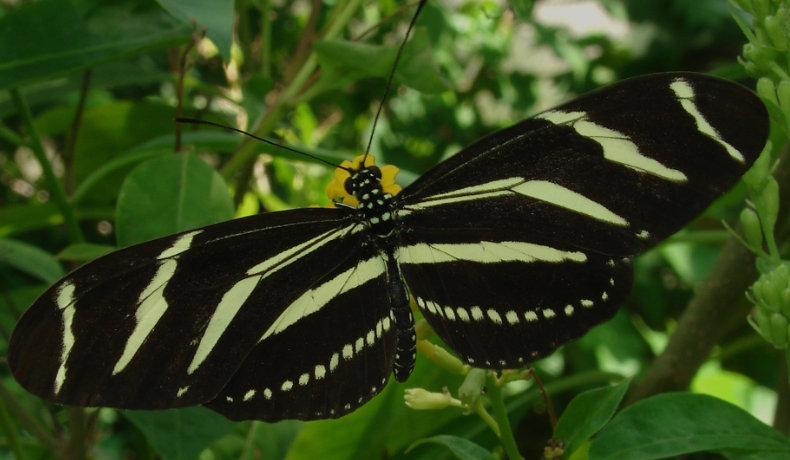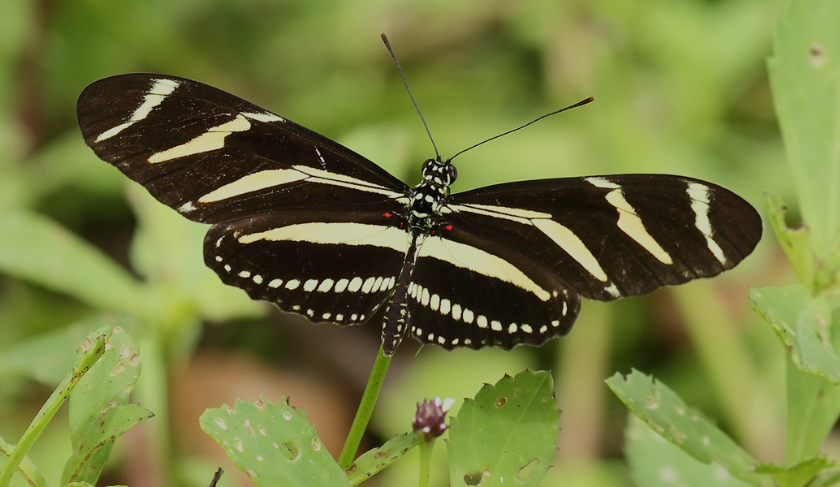
Classification
The Zebra Longwing Caterpillar (Heliconius charithonia) belongs to the family Nymphalidae, under the order Lepidoptera. It is the larval stage of the Zebra Longwing butterfly, a species celebrated for its elongated black wings striped with yellow, resembling zebra markings. Within its classification, it falls under the genus Heliconius, a group known for their unique feeding habits and striking wing patterns. The species itself, H. charithonia, has garnered attention both for its ecological role and its aesthetic appeal, making it one of the most recognizable butterflies in the Americas.
Identifying Characteristics
The Zebra Longwing caterpillar has a white or pale gray body dotted with tiny black spots. Along its back and sides, it bears long, black, branched spines, which serve both as a deterrent to predators and as a means of blending in with the spiny host plants it inhabits. Its head is darker, contrasting with the pale body, and its elongated spines make it appear more threatening than it actually is. This spiny, armored look is one of its key defense mechanisms, along with chemical protection acquired from its host plants.
Distribution, Migration & Habitat
The distribution of Heliconius charithonia is quite broad. It ranges from the southern United States (particularly Florida, Texas, and parts of the Gulf Coast) through Central America, the Caribbean islands, and deep into South America. It thrives in warm climates and can often be found in subtropical and tropical forests, wooded areas, edges of hammocks, and gardens. Unlike many butterflies, Zebra Longwings are capable of limited seasonal movements but are not true long-distance migrants like monarchs. Instead, they may shift habitats locally in search of nectar and suitable host plants.
Predators & Threats
Predators and threats to the Zebra Longwing caterpillar are varied, but the species has evolved effective defenses. The caterpillars feed on passionflower vines (Passiflora spp.), which contain toxic compounds known as cyanogenic glycosides. By ingesting these chemicals, the caterpillars become unpalatable and sometimes poisonous to birds and other predators. Their sharp black spines also discourage would-be attackers, though parasitic wasps and flies remain significant threats, as they lay eggs inside the caterpillars, eventually killing them. Habitat loss and pesticide use also negatively impact their populations.
Lifespan of Adults
The adult Zebra Longwing butterfly has a relatively long lifespan compared to most butterflies, living up to six months under favorable conditions, whereas many other butterfly species survive only a few weeks. This extended life is partly due to their unusual diet—adults not only feed on nectar but also consume pollen, which provides proteins and nutrients that contribute to their longevity. This unique feeding behavior sets them apart from most butterflies.
Host Plants & Diet
When it comes to host plants and diet, the Zebra Longwing caterpillar is closely tied to species of the Passionflower vine (Passiflora). These vines serve as the primary food source for the larvae, giving them both nutrition and chemical defenses. The caterpillars chew through the leaves, sometimes skeletonizing them, but the passionflower plants have evolved strategies such as mimicry and extra-floral nectaries to resist heavy feeding. The adult butterflies continue to rely on nectar plants such as lantana, shepherd’s needle, and verbena, in addition to their pollen sources, which sustain their extended lives.
Life Cycle of Zebra Longwing Caterpillar (Heliconius charithonia)

Egg Stage
The life cycle begins when a female Zebra Longwing butterfly lays her eggs on the tender shoots and leaves of passionflower vines (Passiflora species), the primary host plants for this species. The eggs are yellowish or pale in color, laid singly or in small clusters, usually on new growth where food will be abundant. This careful placement ensures that when the larvae hatch, they have immediate access to nourishment. The egg stage lasts only a few days, depending on temperature and environmental conditions.
Caterpillar (Larval) Stage
Once the eggs hatch, the caterpillars emerge and immediately begin feeding on passionflower leaves. The larval stage is the most active feeding phase, during which the caterpillar rapidly grows, molting several times as it increases in size. The Zebra Longwing caterpillar is white with black spots and armed with long black branched spines that provide protection against predators.
During this period, the caterpillar not only builds its body mass but also accumulates toxins from the passionflower, making it distasteful or poisonous to many predators. This stage usually lasts two to three weeks.
Pupa (Chrysalis) Stage
After reaching full size, the caterpillar enters the pupal stage. It attaches itself to a stem or leaf using silk and then forms a chrysalis. The pupa is brownish and angular, resembling dried leaves or plant matter, which offers camouflage against predators.
Inside the chrysalis, remarkable metamorphosis takes place: the caterpillar’s tissues reorganize into the adult butterfly form. This stage typically lasts about 10 to 14 days, though it can vary depending on environmental conditions.
Adult Butterfly Stage
The final stage is the emergence of the adult Zebra Longwing butterfly. Once out of the chrysalis, the butterfly expands and dries its wings before taking flight. Adults are easily recognized by their long, narrow, black wings striped with yellow bands, resembling zebra markings.
Unlike most butterflies, adult Zebra Longwings feed not only on nectar but also on pollen, which provides them with proteins and nutrients. This unique diet contributes to their long lifespan—up to six months, far longer than most butterfly species. During this stage, adults focus on feeding, mating, and continuing the cycle by laying eggs on passionflower vines.